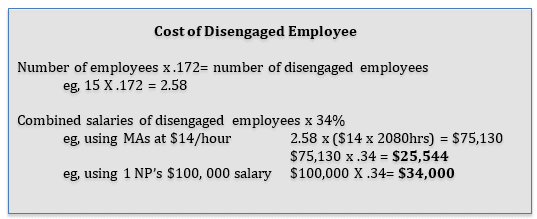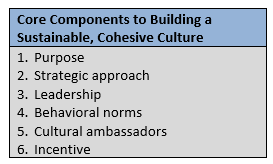Published on
Urgent message: High-profile teambuilding extravaganzas may get your crew pumped up—once or twice a year, and assuming you can shut down your operation for the day. In the 7-day-a-week culture of urgent care, however, you may get better results by making it a day-to-day commitment.
Amy Lafko, MSPT, MBA
What you will find in this article?
- ROI of teambuilding
- Assess the current state of your team
- Tools to foster teamwork in a sustainable way
There are hundreds of articles about teambuilding activities like ziplining, ropes courses, and escape rooms. While these activities can jumpstart more effective teams, you’re thinking to yourself, We are open 7 days a week, 12 hours a day. When exactly can we take the time to go to an escape room?!
And what is the goal of all of this “teambuilding” anyway? According to Oxford Living Dictionaries, teambuilding is the action or process of causing a group of people to work together effectively as a team, especially by means of activities and events designed to increase motivation and promote cooperation. Well, that certainly sounds good but again, where do we find the time? I want to reframe the thinking about teambuilding activities from once a quarter events to daily habits.
ROI of Teambuilding
In order to calculate the ROI of teambuilding, we need to first establish what teambuilding is actually meant to accomplish:
- Trust among team members
- Increased productivity: efficiently working together
- Effective group communication
- Understanding team member strengths and interests
- Healthy conflict leading to better decisions
- Alignment toward the same goals
- Positive peer pressure to perform
- Engage people to give their discretionary effort
- Increased patient satisfaction
- Team-oriented culture that promotes retention
Gallup found that an actively disengaged employee costs their organization $3,400 for every $10,000 in salary (34% of salary). This cost reflects lost productivity, poor communication or decision-making, etc. Gallup predicts that in any given organization, 17.2% of employees are disengaged.1 Now, you know your team and hopefully you are measuring engagement so use your numbers if you have them.

That is only one calculation we need to do. Another key calculation is the cost of turnover. According to Bureau of Labor statistics, at a minimum, every time you replace a position it costs your company 33% of salary and benefits. This 33% includes recruitment cost, time lost to interviewing and onboarding, plus new hire not at full productivity. So looking at the same salaries with 20% benefit load:

An even more grim calculation comes from the Society of Human Resource Management (SHRM), which estimates 6-9 months of salary per lost employee. These are some scary numbers and they don’t even take into account the lost productivity caused by poor communication, lack of decision-making, conflicts, etc.
Assess the Current State of Your Team
To assess the current state of your team, there are several data points for you to consider. As we saw in the previous calculation, turnover costs money and you need data points about turnover and retention rates. Examine overall turnover rate and then break the rate down by position and location. Track your retention rates by tenure, as well as by position.
Unless you have a small practice, you need to measure employee engagement. Many places choose not to do these surveys because they say they won’t get “real” information. Depending on how you present the concept, that may be true, but with the right foundation a survey can provide incredibly valuable data.
Think of it like the value of taking vital signs as part of a visit; if you don’t take them correctly, they are useless. These surveys don’t have to be complex or time-consuming. With most of my clients, we ask no more than a handful of questions that truly get to the heart of engagement. The best thing about successfully measuring employee engagement is that it will give you the roadmap to improvement specific to your organization.
Some elements of teamwork and engagement that you may not automatically consider include things like worker’s comp claims. Take a look at your quality outcomes and how many patient safety events occur. Are people being lax in safety and quality because they don’t communicate well or just don’t care? A significant indicator is patient satisfaction. I will never forget the time I took a role in an urgent care facility and on day 3 someone told me, “We will never care about these people until management cares about us.”
Tools to Foster Teamwork in a Sustainable Way
Many of you might feel compelled to combat turnover and other issues with team dynamics by simply throwing money at the problem (or at your employees). You might want to rethink that in light of a Harvard Business Review article on a meta-analysis of 92 quantitative studies that found “the association between salary and job satisfaction is very weak. The reported correlation indicates that there is less than 2% overlap between pay and satisfaction levels.”2
You might also decide that based on the calculations in section 1, a teambuilding event is certainly cheaper than turnover. That’s true, but one or two events a year won’t transform a negative culture into a teamwork-oriented culture. In order to create a sustainable, cohesive culture, you need to address six core components. To get a better understanding of those six components, let’s compare them to a teambuilding activity in an escape room.

- Purpose. In an escape room, there is a clear purpose with priorities delineated. We want to get out of the room. In your organization, you also need a clearly defined purpose with established priorities. If your mission, vision, and values statement are in a binder or hanging behind a door, then I don’t consider those purpose. If your team can reference them and how they impact their work each day, then yes—your mission statement is your purpose. More often than not, purpose is actually the unspoken activities that are encouraged, or statements made by senior leaders. If you don’t have a purpose that is motivating and compelling to the frontline team members, then creating that is priority #1. An organization I work with has added several marketing components to their performance review, things like the number of favorable Yelp reviews and number of community events; this has left the employees feeling like their role is similar to a car salesperson instead of a healthcare professional.
- Strategic approach. If you want to get out of the escape room, you have to do it in a step-by-step manner. You have to solve the first clue to get the second clue. Similarly, if you want to make progress with your culture, you need to have a plan that is well thought out. Use the data you have collected as a starting point. After getting the results of an employee engagement survey, one of the first things I do with clients is create a strategic plan for the year based on action items and milestones that will affect the feedback we received. Determine which step will have the greatest impact and move in that direction. What elements must be in place before you can roll out the next phase? By creating a strategic approach, you will be more likely to achieve the goal.
- A strategic approach only works if you have leaders who are skilled at carrying it out. They need to be able to communicate the purpose, create dialogue, and build trust. We talk about methods of communication all the time, yet people forget the most common route of communication from corporate to frontline is through the clinic manager. It’s important to remember professional development as part of your strategic approach. Train people in conflict resolution, providing feedback, holding other accountable, etc. In-person development workshops bring huge value, but there are also online video resources that support ongoing leadership development.
- Behavioral norms. Aristotle told us, “We are what we repeatedly do.” In an escape room, we see people step up to take charge, while others gravitate to their strengths and some people get frustrated or simply stop doing their part. What are the “stories” that are told to new people about “how we do things around here”? Are there behavioral norms you are pretending don’t negatively impact your culture? What behavioral norms are you encouraging and positively reinforcing? It is important that you help build stories and behaviors that align with the culture you want.
- Cultural ambassadors. These are the cheerleaders in the escape room. They may be the ones on the sidelines cheering or they may be the ones in the thick of getting to the goal. In your organization, you have these ambassadors at every location. Get to know who they are and support them.
- In an escape room, the aim is to succeed in getting out. That sole purpose is ample incentive to motivate people. Now think about how motivating your purpose is. As we saw in the research, money isn’t the motivator. Yes, it has an impact but if you are paying a fair wage and have decent benefits, people will stay for a great team. Your incentive plans have to align with the hearts and minds of your people. Get creative with incentives. What do they really want and need?
Back to our original question, are those teambuilding activities really worth it?
I’m not suggesting these activities aren’t useful. After all, when you are getting out of an escape room people have a common purpose, strengths are exposed, leaders emerge, and communication has to be effective for the team to succeed. Taking the team offsite can help refresh people, build camaraderie, and be fun. I am suggesting that successful teambuilding does not take place during a twice-a-year teambuilding experience. Your culture exists every day and if you want a strong team, those habits and behaviors need to be reinforced on a daily basis.
References
- Gallup 2016 State of the American Workforce study.
- Chamorros-Premuzic T. Does money really affect motivation? A review of the research. Harvard Business Review. Available at: https://hbr.org/2013/04/does-money-really-affect-motiv. Accessed May 10, 2019.
Amy Lafko, MSPT, MBA is the founder and principal of Cairn Consulting Solutions. The author has no relevant financial relationships with any commercial interests.
